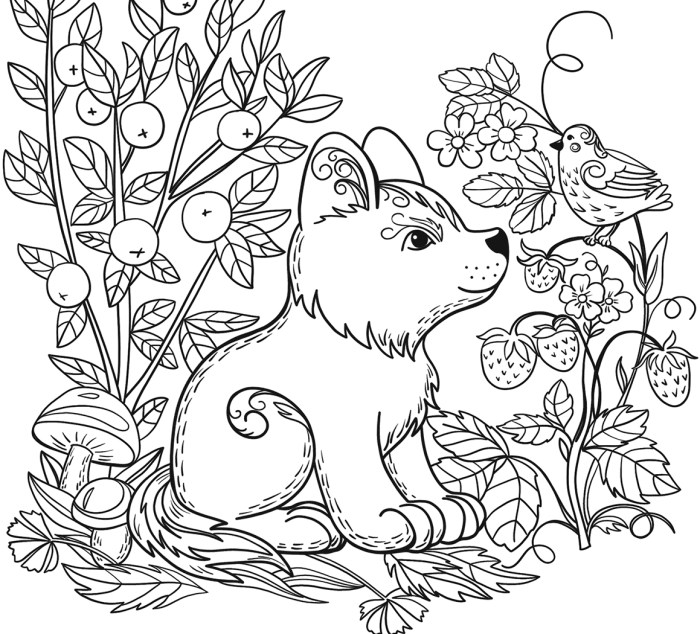Design Elements: Animal Coloring Page Realistic

Animal coloring page realistic – Creating appealing and realistic animal coloring pages requires a careful consideration of several design elements. The goal is to produce a page that is both engaging for the user and accurately represents the chosen animal. This involves thoughtful line art, nuanced shading techniques, and an understanding of animal anatomy and texture. Success hinges on the ability to translate the complexity of the animal’s features into a format suitable for coloring while retaining a sense of realism.
Essential Characteristics of High-Quality Realistic Animal Coloring Pages
High-quality realistic animal coloring pages prioritize accuracy and detail. The line art should be clean and precise, clearly defining the animal’s form and features without being overly simplistic or overly complex. The level of detail should be appropriate for the target age group, balancing challenge with accessibility. A well-designed page will incorporate subtle variations in line weight to suggest depth and form, avoiding harsh, uniform lines.
The overall composition should be pleasing to the eye, with the animal positioned effectively within the page boundaries. The page should be free of distracting elements, allowing the focus to remain on the animal illustration itself.
Effective Line Art Techniques for Realistic Animal Illustrations, Animal coloring page realistic
Achieving realistic animal illustrations relies on mastering several line art techniques. One key technique is the use of varying line weights. Thicker lines can be used to define the animal’s contours and create a sense of volume, while thinner lines can be used for finer details like fur texture or individual feathers. Another effective technique is the use of hatching and cross-hatching to create shading and depth.
By varying the density and direction of the hatching, artists can suggest the texture of fur, scales, or feathers. Finally, the use of contour lines can be crucial in defining the animal’s form and giving it a three-dimensional quality. For instance, subtle curves and variations in line direction can suggest the roundness of an animal’s body or the musculature of its legs.
Consider a lion’s mane; thicker lines define the overall shape, while thinner lines create individual strands, conveying a sense of volume and texture.
Methods for Achieving Realistic Fur, Scales, and Feathers in a Coloring Page Design
Realistic depictions of fur, scales, and feathers require specific approaches. For fur, short, closely spaced lines can suggest a smooth coat, while longer, more varied lines can depict a thicker, shaggier coat. The direction of the lines should follow the animal’s natural fur growth patterns. Scales can be rendered using overlapping, slightly curved lines, creating a textured surface.
The size and shape of the scales can vary to create realism, with larger scales often appearing on the body and smaller scales on the extremities. Feathers require careful attention to detail. Individual feathers can be suggested using delicate, slightly curved lines, while larger feather groups can be represented by areas of closely spaced hatching or cross-hatching.
The overall texture and pattern of the feathers should be considered to accurately reflect the bird’s species. For example, an owl’s soft downy feathers would be rendered differently from a peacock’s iridescent plumage.
Common Pitfalls to Avoid When Designing Realistic Animal Coloring Pages
Careful planning is essential to avoid common pitfalls. The following table Artikels several common problems and their solutions:
| Pitfall | Solution | Pitfall | Solution | ||||
|---|---|---|---|---|---|---|---|
| Overly complex line art that is difficult to color | Simplify the line art, focusing on key features and avoiding excessive detail. | Inconsistent line weight, creating a messy appearance | Maintain a consistent line weight throughout the illustration, using variations only to suggest depth and form. | Poorly defined anatomical features, resulting in an unrealistic depiction | Study anatomical references and ensure that the animal’s proportions and features are accurate. | Lack of variation in shading and texture, creating a flat appearance | Use hatching, cross-hatching, and varying line weights to create shading and texture, suggesting depth and realism. |
Realistic animal coloring pages offer a valuable tool for developing fine motor skills and observational abilities. A comprehensive resource for such activities can be found by exploring various online collections, such as the diverse range of options available at amazon animals coloring pages , which provides numerous depictions of Amazonian fauna. These pages, in turn, can enhance understanding of animal morphology and contribute to a more detailed appreciation of realistic animal representation.


